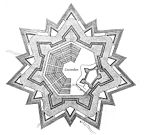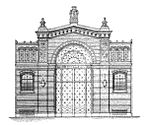Architectural
plan
An architectural
plan is a plan for architecture,
and the documentation of written and
graphic descriptions of the
architectural elements of a building
project including sketches,
drawings and details.
 Heidelberg
Schloss
Plan, 1888.
Heidelberg
Schloss
Plan, 1888.
Overview
The term
"Architectural plan" can have multiple
related meanings:
- Plan
for an architectural
project
- Documentation
of written and graphic descriptions
of the architectural elements of a
building project including sketches,
drawings and details. This effort
could also includes both the design
of new buildings and other
structures, as well as the planning
for reconstruction of early historic
structures.
- architectural
design
- Floor
plan
- Scale drawing
of a structure. "the plans for City
Hall were on file".
This
article will focus on the general
meaning of architectural plan as a
plan and documentation for a building
project.
An
architectural plan is a type of plan
for architecture to describe a place
or object, or to communicate building
or fabrication instructions. It can
containing technical architectural
drawings and documentation, and are
drawn or printed on paper, but they
can take the form of a digital file.
Their purpose in these disciplines is
to accurately and unambiguously
capture all the geometric features of
a site, building, product or
component. Plans can also be for
presentation or orientation purposes,
and as such are often less detailed
versions of the former. The end goal
of plans is either to portray an
existing place or object, or to convey
enough information to allow a builder
or manufacturer to realize a design.
Types of
architectural plans
Floor
plan
A floor
plan in architecture and building
engineering is a diagram, usually to
scale, of the relationships between
rooms, spaces and other physical
features at one level of a structure.
Dimensions are usually drawn between
the walls to specify room sizes and
wall lengths. Floor plans will also
include details of fixtures like
sinks, water heaters, furnaces, etc.
Floor plans will include notes to
specify finishes, construction
methods, or symbols for electrical
items.
Similar
to a map in an floor plan the
orientation of the view is downward
from above, but unlike a conventional
map, a plan is understood to be drawn
at a particular vertical
position(commonly at about 3 feet
above the floor). Objects below this
level are seen, objects at this level
are shown 'cut' in plan-section, and
objects above this vertical position
within the structure are omitted or
shown dashed. Plan
view or "plan form" is
defined as a vertical orthographic
projection of an object on a
horizontal plane, like a map.
Floor plan for a single-family home.
Garden design
Garden
design is the art and process of
designing and creating plans for
layout and planting of gardens and
landscapes. Garden design may be done
by the garden owner themselves, or by
professionals of varying levels of
experience and expertise. Most
professional garden designers are
trained in principles of design and in
horticulture, and have an expert
knowledge and experience of using
plants. Some professional garden
designers are also landscape
architects, a more formal level of
training that usually requires an
advanced degree and often a state
license. Many amateur gardeners also
attain a high level of experience from
extensive hours working in their own
gardens, through casual study or Master Gardener
Programs offered by the
American Horticultural Society.
Landscape plan
Landscape
planning is a branch of landscape
architecture. Urban park systems and
green-ways of the type planned by
Frederick Law Olmsted are key examples
of urban landscape planning.Landscape
designers tend to work for clients who
wish to commission construction work.
Landscape planners can look beyond the
'closely drawn technical limits' and
'narrowly drawn territorial
boundaries' which constrain design
projects.
Landscape
planners tend to work on projects
which:
- are of broad geographical scope
- concern many land uses or many
clients
- are implemented over a long period
of time
In rural
areas, the damage caused by unplanned
mineral extraction was one of the
early reasons for a public demand for
landscape planning.
Site plan
A site
plan is an architectural plan, and a
detailed engineering drawing of
proposed improvements to a given lot. A
site plan usually shows a building
footprint, travel-ways, parking,
drainage facilities, sanitary
sewer-lines, water lines, trails,
lighting, and landscaping.
Such a
plan of a site is a graphic
representation of the arrangement of
buildings, parking, drives,
landscaping and any other structure
that is part of a development project.
A site
plan is a set of construction
drawings that a builder or
contractor uses to make improvements
to a property. Counties can use the
site plan to verify that development
codes are being met and as a
historical resource. Site plans are
often prepared by a design consultant
who must be either a licensed
engineer, architect, landscape
architect or land survey.

Example
of an Site plan.
Transportation
plan
Transportation
planning
is the field involved with the siting
of transportation facilities
(generally streets, highways,
sidewalks, bike lanes and public
transport lines).
Transportation
planning
historically has followed the rational
planning model of defining goals and
objectives, identifying problems,
generating alternatives, evaluating
alternatives,and developing the plan.
Other models for planning include rational actor,
satisficing, incremental
planning, organizational
process, and political bargaining.
However, planners are increasingly
expected to adopt a multi-disciplinary
approach, especially due to the rising
importance of environmentalism. For
example, the use of behavioral
psychology to persuade drivers to
abandon their automobiles and use
public transport instead. The role of
the transport planner is shifting from
technical analysis to promoting
sustainability through integrated
transport policies.
Urban plan
Urban,
city, and town planning is the
integration of the disciplines of land
use planning and transport
planning, to explore a very
wide range of aspects of the built and
social environments of urbanized
municipalities and
communities.Regional planning deals
with a still larger environment, at a
less detailed level.
Based
upon the origins of urban planning
from the Roman (pre-Dark Ages) era,
the current discipline revisits the
synergy of the disciplines of urban
planning, architecture and landscape
architecture, varying upon from the
interlectural strategic positioning
from university to university.
Another
key role of urban planning is urban
renewal, and re-generation of inner
cities by adapting urban planning
methods to existing cities suffering
from long-term infrastructural decay.

Urban
planning designs settlements,
from the smallest towns to the
largest cities.
Architectural
plan topics
Plan
A plan
is typically any procedure used to
achieve an objective.
It is a set of intended actions,
through which one expects to achieve a
goal. Plans can be formal or informal:
- Structured
and formal plans, used by multiple
people, are more likely to occur in
projects, diplomacy, careers,
economic development, military
campaigns, combat, or in the conduct
of other business.
- Informal
or ad-hoc plans are created by
individuals in all of their
pursuits.
The most
popular ways to describe plans are by
their breadth, time frame, and
specificity; however, these planning
classifications are not independent of
one another. For instance, there is a
close relationship between the
short-and long-term categories and the
strategic and operational categories.
It is common for less formal plans to
be created as abstract ideas, and
remain in that form as they are
maintained and put to use. More formal
plans as used for business and
military purposes, while initially
created with and as an abstract
thought, are likely to be written
down, drawn up or otherwise stored in
a form that is accessible to multiple
people across time and space. This
allows more reliable collaboration in
the execution of the plan.
Plan view
A plan view
is an orthographic projection of a
3-dimensional object from the position
of a horizontal plane through the
object. In other words, a plan is a
section viewed from the top. In such
views, the portion of the object in
above the plane is omitted to reveal
what lies beyond. In the case of a
floor plan, the roof and upper portion
of the walls may be omitted.
Roof
plans are orthographic projections,
but they are not sections as their
viewing plane is outside of the
object. A plan is a common method of
depicting the internal arrangement of
a3-dimensional object in two
dimensions. It is often used in
technical drawing and is traditionally
crosshatched. The style of cross
hatching indicates the type of
material the section passes through.

A
sample floor plan for a
single-family home
Planning
Planning
in organizations
and public policy is both the
organizational process of creating and
maintaining a plan; and the
psychological process of thinking
about the activities required to
create a desired goal on some scale.
As such, it is a fundamental property
of intelligent behavior. This thought
process is essential to the creation
and refinement of a plan, or
integration of it with other plans,
that is, it combines forecasting of
developments with the preparation of
scenarios of how to react to them.
The term
is also used to describe the formal
procedures used in such an endeavor,
such as the creation of documents
diagrams, or meetings to discuss the
important issues to be addressed,the
objectives to be met, and the strategy
to be followed. Beyond this, planning
has a different meaning depending on
the political or economic context in
which it is used.
Examples of
plans for specific types of
buildings

Bank
plan
|

Bunker
plan
|

Castle
plan
|

Fortress
plan
|

Hospital
plan
|

House
plan
|

Legislative
building plan
|

Library
plan
|

Market
hall plan
|

Mill
plan
|

Museum
plan
|

Office
building
plan
|

Opera
house plan
|

Palace
plan
|

Religious
building plan
|

School
building plan
|

Theater
plan
|

Train
station plan
|

University
building plan
|
|
Back to the Top